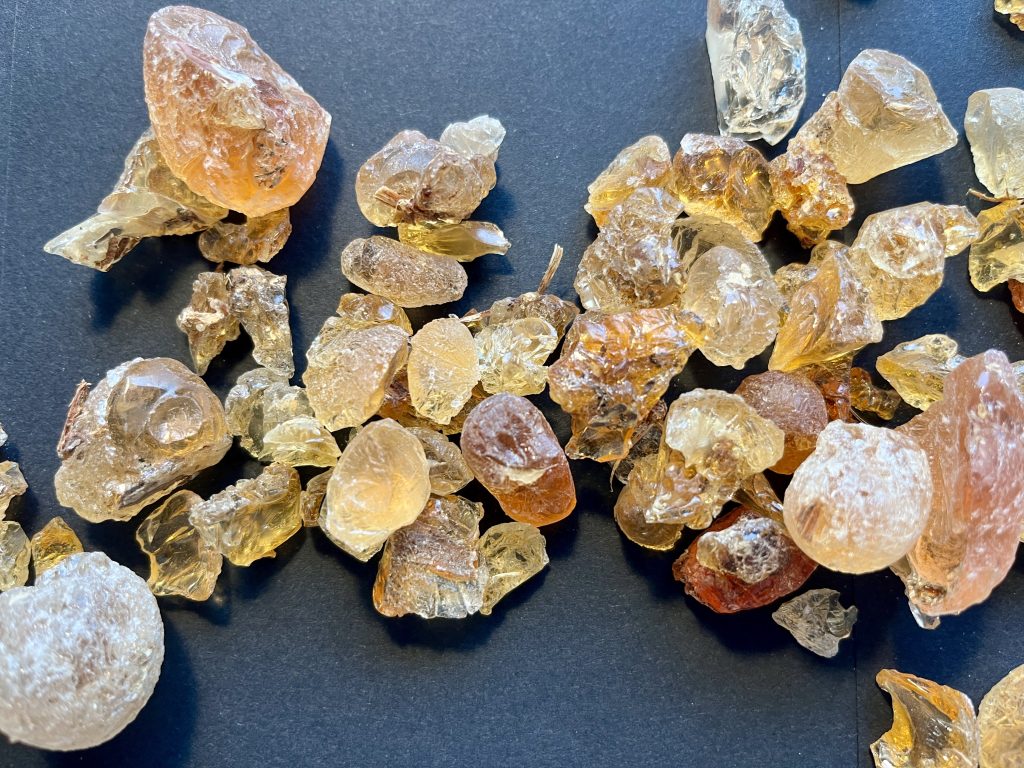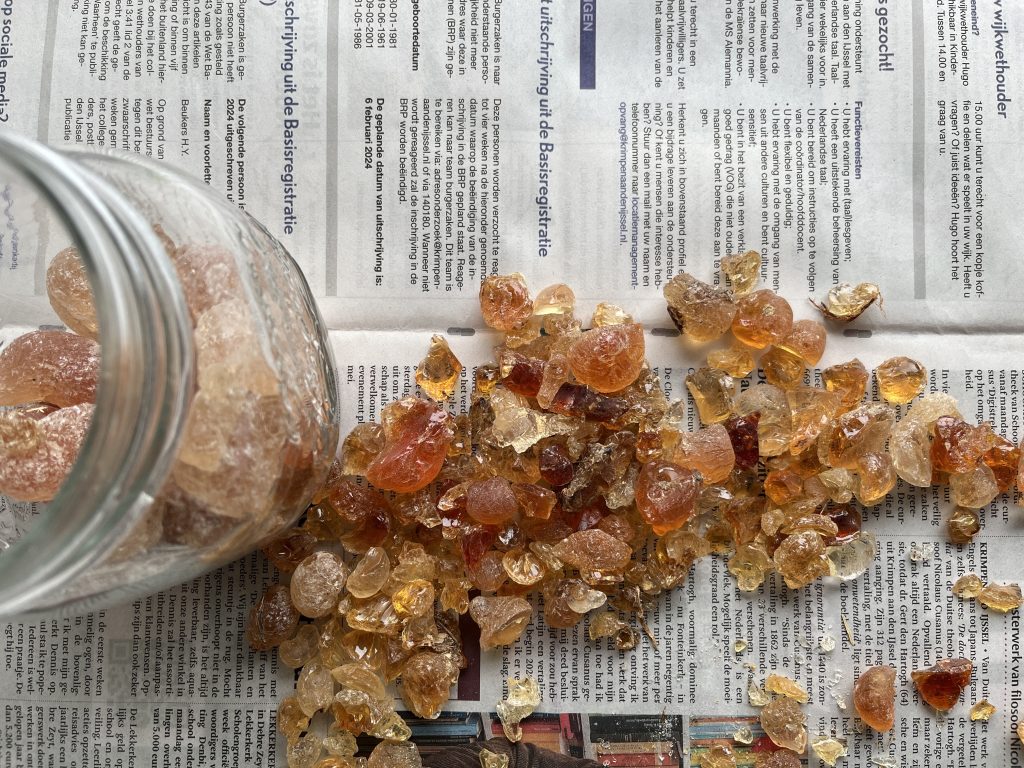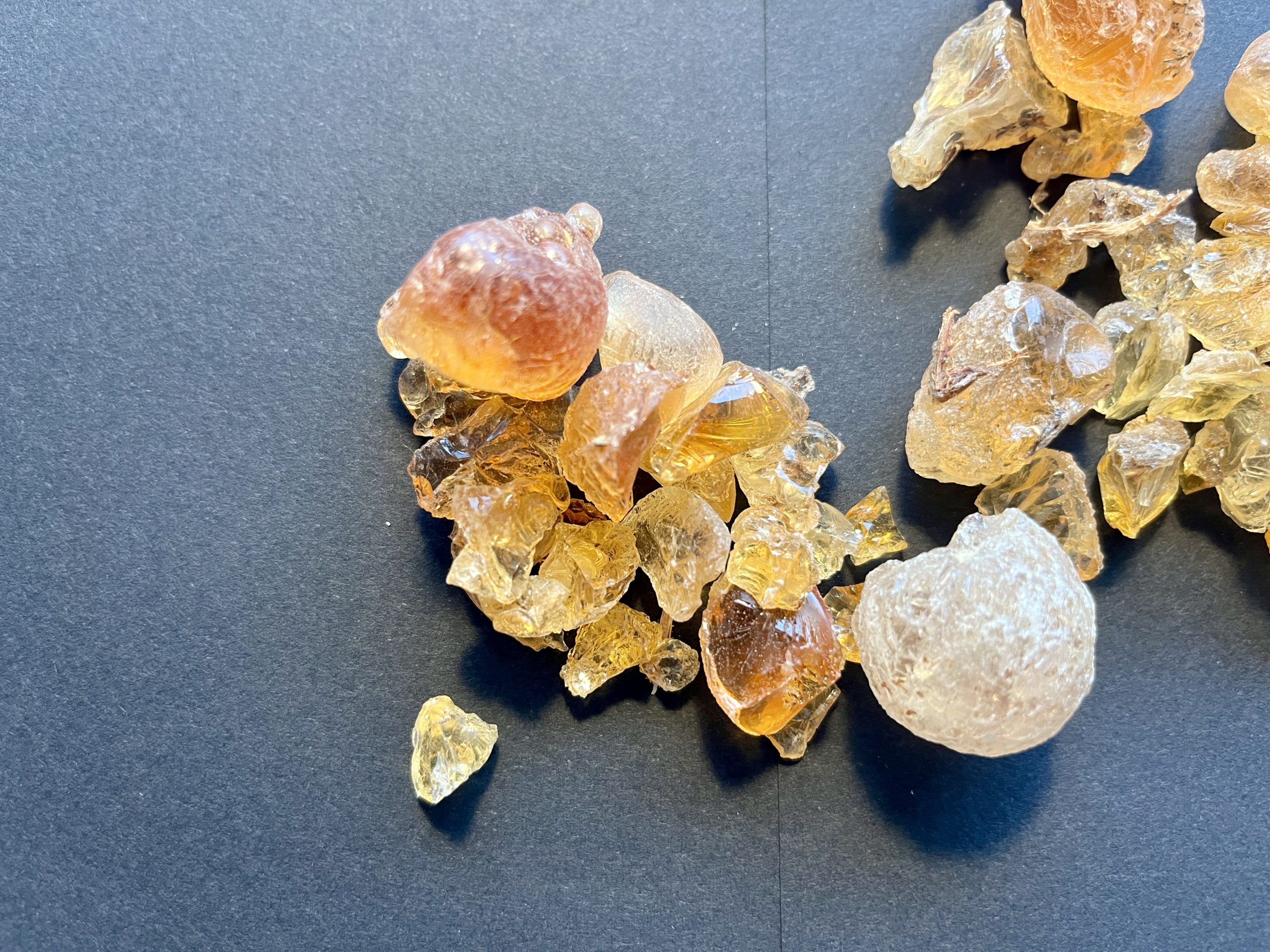Solution of gum Arabic as a binder and adhesive for gold leaf.


Gum Arabic from dark to light. The lighter the color the better the quality of the gum.
Gum Arabic in addition to clarified egg white or also called glair, was one of the most used binders for making paint in manuscripts. Furthermore it was also used as an adhesive for applying gold leaf. (Gold ground).
The author of the work: (Liber diversarum arcium 1*) states that the gum originated in Africa and that there were three qualities. The best was the white gum. Less of quality was the yellow gum. Least in quality was the even darker kind. The gum was easy to prepare and was sold in lumps. These were pulverized and dissolved in water. Then the solution was tested between two fingers. If the fingers stuck slightly the solution was good otherwise more water had to be added. Then it was filtered with a linen cloth and mixed with the pigments.

Acacia senegal
Gum is a plant secretion (polysaccharide) derived from various trees or shrubs. Gums are used to increase the viscosity of a liquid. They are quite often confused with resins but differ from them in that gums are water-soluble while resins are not. It can look like a sticky liquid that solidifies in the form of droplets or in transparent lumps. Gum dissolves completely in hot and cold water. Gum is an important element in painting. When using water paints, the dose varies depending on the color. For example, yellow earth has little, but modern Prussian blue, on the other hand, needs a lot of gum Arabic. Furthermore, medieval blues were also tempered with size, collagen glue. These, along with gum Arabic, were stronger binders than the clarified egg white.
Gum Arabic comes from several species of acacia trees that grow in Africa, Australia, and Asia. It reaches us in the form of white, yellow, slightly red transparent and loose grains. It is odorless slimy and sweetish. The pieces or grains that tend to a red color are the least valuable. Gum Arabic is used as a binder; it dissolves completely in water and has great adhesive strength. It dries transparently like varnish and is water-soluble again after drying. After years, it may crack. In the Middle Ages, honey or sugar was added to the gum Arabic to prevent this from happening.
Therefore, it is advised to use gum Arabic sparingly. For gold powder binding, it is better to use fish glue or glue made from gelatin. Gum Arabic dulls the gold powder.

Shell gold made from gold powder (“Mussel Gold”).
The origin of gum Arabic in the Middle Ages was not always clear. Much of what passed under the name gum arabic came from apricot – cherry – or plum trees and was certainly not from ‘Arabia’. Understandably, however, people also used the lesser quality cherry gum because, after all, it was available nearby. Apricot, plum and cherry trees grew in many places.

Test strip of Ultramarine blue tempered with gum Arabic.

Cherry gum.

However, the solutions of these locally available gums (from prunus species) are different from those of gum Arabic. Cherry gum swells in water to form a kind of jelly and never becomes as liquid as dissolved gum Arabic.
The major advantages of gum Arabic are:
- It is easily soluble in water.
- Has good adhesive strength.
- Makes colors more intense.
The disadvantage is that it can become somewhat brittle and flake. Therefore, honey was often added as a plasticizer and kept the paint from flaking.
From: The Arte Illuminandi
Gum solution: Recipe for laying gold leaf :
“Take white clean gum Arabic and break it into small pieces or grind it and put it in a glazed dish. And pour enough water over it so that it comes to two fingers deep and let it stand a day and a night and then put it in the hot ash for a while to dissolve and test it just as you tested the “planeerwater’ (2*). And when it is well tempered, such that it is not too strong or too weak, strain it through a cloth and keep it in a bottle and use it.”
From: “De Coloribus Faciendis ” by Jean le Bègue. ( 3*)
Gum solution for the preparation of paint:
“When mixing colors for painting in books, make a binder of the brightest gum arabic and water, as before, and mix it with all colors except green and ceruse (lead white), minium (red lead), and carmine. Salt green is unusable in a book. Spanish green should be made with wine, and if you want to make it darker, add a little of the juice of sword grass, or cabbage, or leeks. You should mix minium and ceruse, and carmine, with egg white”.
Making your own Arabic gum solution

- Pick out some pieces that match a little in terms of their size.

2. We now weigh the gum Arabic, for this session I took 30 grams. Put them in the mortar and crush them with the pestle.

3.Put the crushed gum in a bowl or jar and add two parts of demineralized water. (In this case, 60 to 75 ml. of demineralized water).

4. Let it soak for 24 hours and if you have less patience, you can heat the solution au bain-marie.

5.
“And when it is well tempered, such that it is neither too strong nor too weak , strain it through a cloth and keep it in a bottle and use it ”. (From: De Arte Illuminandi).
Filter the dissolved mass through a sieve or nylon sock. I personally use a linen cloth for this purpose. This is a little more difficult if the solution is very thick, so I make it a little thinner. Proper filtering is very important especially if you are going to use the solution for gold leaf. Any unevenness will show through the gold layer.

Filtering is important so we can clearly see in this picture. Thirty grams of gum contains quite a lot of impurities. Made the solution (slightly more aqueous) and filtered twice with a clean linen cloth.

6

6. Put the solution in a jar and use the solution for paint. When using for water-based paint, it is important to add some honey to the solution made.
(5 grams of solution is equivalent to 1 gram of honey water). I also add a drop of light clove oil for preservation.
Always make samples of the paint you have made that avoids disappointment.
(Liber diversarum arcium 1*)
The anonymous Liber diversarum arcium (“book of various arts”) is a medieval handbook for painting. It contains more than 500 art technological instructions or recipes in Latin. Together, these make up a complete painting course. It is probably the most comprehensive medieval technical recipe book for painters that has survived, and it summarizes the state of technology in European workshops of the fourteenth century.
It is kept in the Bibliothèque universitaire, section médecine, Montpellier, France. The work is found in another manuscript dating to 1430 and originated somewhere in or near Venice. The contents reflect mainly Northern European painting practices, and probably date from the period around 1300. It consists partly of compilations of earlier technical recipes (but edited to make them more useful), and partly of newly compiled material. Various material (much Italian) was added during the fourteenth century.
Planeerwater (2*)
Glue water – size.
From: “De Coloribus Faciendis ” by Jean le Bègue. (3*)
This recipe is from the translation of: Mrs. Mary P. Merrifield, Medieval and Renaissance Treatises on the Arts of Painting. Page 156 / 79.
The work itself can be viewed digitally:
https://gallica.bnf.fr/ark:/12148/btv1b10525796f/f1.item
Furthermore, for the recipes I use the extremely useful booklet by:
Marc Niederhauser: “Alchemie de l’enluminure” 80 recettes éprouvées”.
The booklet is unfortunately long sold out but is still available as an eBook.
